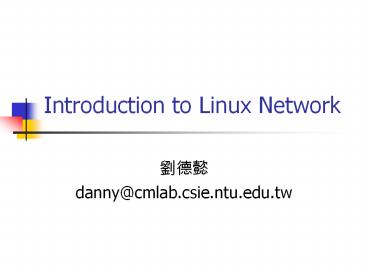Introduction to Linux Network - PowerPoint PPT Presentation
Title:
Introduction to Linux Network
Description:
INET Layer use sock data structure to handle BSD socket. Creating a BSD Socket ... Trim. References. The Linux Kernel, chapter 10. Linux Kernel Internals, chapter 8 ... – PowerPoint PPT presentation
Number of Views:440
Avg rating:3.0/5.0
Title: Introduction to Linux Network
1
Introduction to Linux Network
- ???
- danny_at_cmlab.csie.ntu.edu.tw
2
Outline
- OSI and TCP/IP Overview
- Linux Networking Layers
- BSD Socket Interface
- INET Socket Interface
- An Example of Socket Programming
3
OSI Overview
- OSI (Open Systems Interconnection)
- See Figures
4
(No Transcript)
5
(No Transcript)
6
TCP/IP Model
- OSI TCP/IP
7
6
5
4
3
2
1
Application
Presentation
Session
Transport
Network
Data Link
Physical
Application
Transport
Internet
Host-to-Network
Not present
TCP
IP
7
TCP Overview
- TCP (Transmission Control Protocol)
- Connection-Oriented
- Reliable Protocol
- UDP (User Datagram Protocol)
- Connectionless
- Unreliable Protocol
8
IP Overview
- 32-bit Unique IP Address
- Network Address
- Subnet Address
- Host Address
Gateway (Router)
140.112.30.XX
140.112.28.XX
9
IP Overview (cont.)
- IP Header
10
Ethernet Layer
- 48-bit Unique Device Address
- ARP (Address Resolution Protocol)
multicast
multicast
multicast
multicast
11
Linux Networking Layers
- Support Mechanism
- Various Networking
- Inter-Process Communication
- A Special Kind of Pipe
- Support Several Address Family
- Support Several Socket Type
12
Addr Family Description
UNIX Unix domain sockets
INET Internet address family support TCP(UDP)/IP
AX25 Amateur radio X25
IPX Novell IPX
APPLETALK Appletalk DDP
X25 X25
13
Socket Type Description
Stream Reliable, Sequenced, Like TCP
Datagram Unreliable, Not sequenced, Like UDP
Reliable Delivered Messages Like datagram but reliable
Sequenced Packet Like Stream but fixed size packet
14
Network Applications
User
Kernel
BSD Sockets
Socket Interface
INET Sockets
TCP
UDP
Protocol Layers
IP
ARP
Network Devices
PPP
SLIP
Ethernet
15
Client/Server Communication
Client
Server
Connect
1. Create a socket
4. Create a socket
Accept
2. Bind an addr
3. Listen the client
Send Recv
16
BSD Socket API
- See An Example
17
BSD Initialization
- void __init proto_init(void)
18
The INET Layer
- BSD Socket
- A part of VFS inode
- A socket can be operated just the same as a file
by system call read(), write(), lseek() - INET Layer use sock data structure to handle BSD
socket
19
Creating a BSD Socket
- For both client and server
- int socket(int family, int type, int protocol)
- Ex. fdSocket(AF_INET, SOCK_STREAM,0)
20
files_struct
count close_on_exec open_fs fd0 fd1 fd255
BSD Socket File Operations
file
f_mode f_pos f_flags f_count f_owner f_op f_inode
f_version
lseek read write select ioctl close fasync
inode
socket
SOCK_STREAM
type protocol data (sk)
Address Family socket operations
SOCK_STREAM
sock
type protocol socket
Linux BSD Socket Data Structure
21
Binding an Address
- Only for Server
- Int bind(int sockfd, const struct sockaddr
address, size_t add_len) - Port Number is optional for binding
- socket.socket_state TCP_CLOSE
- The bound socket cant be used for other
communication
22
Binding an Address (cont.)
- The bound addr was saved in sock.rcv_saddr
- UDP maintains a hash table udp_hash to allocate
UDP port - TCP doesnt add the binding sock to hash table
during binding operation
23
Listening
- Only for server
- int listen(int sockfd, int queue_size)
- socket.socket_state TCP_LISTEN
- Add the sock to tcp_bound_hash and
tcp_listening_hash
24
Listening (cont.)
- After receiving clients request
- Server build a new sock
- Clones the incoming sk_buff and queues it to the
listening sock.receive_queue
25
Connecting
- Only for client
- Before connecting,
- socket.socket_state SS_UNCONNECTED
- Int connect(int csockfd, const struct sockaddr
address, size_t add_len) - Add the sock to tcp_listening_hash waiting for
servers response
26
Accepting
- Only for server
- int accept(int sockfd, struct sockaddr address,
size_t add_len) - A new socket was cloned from the listening socket
27
Accepting (cont.)
- If there are no incoming connection to accept
- Non-Blockingaccept operation failed and throw
away the new socket - Blockingaccept operation was added to the wait
queue
28
next
prev
dev
head
data
tail
end
Packet to be transmitted
sk_buffer structure
- Push
- Pull
- Put
- Trim
len
truesize
29
References
- The Linux Kernel, chapter 10
- Linux Kernel Internals, chapter 8
- Unix System Programming, chapter 10
- Computer Networks, chapter 1, 5, 6































